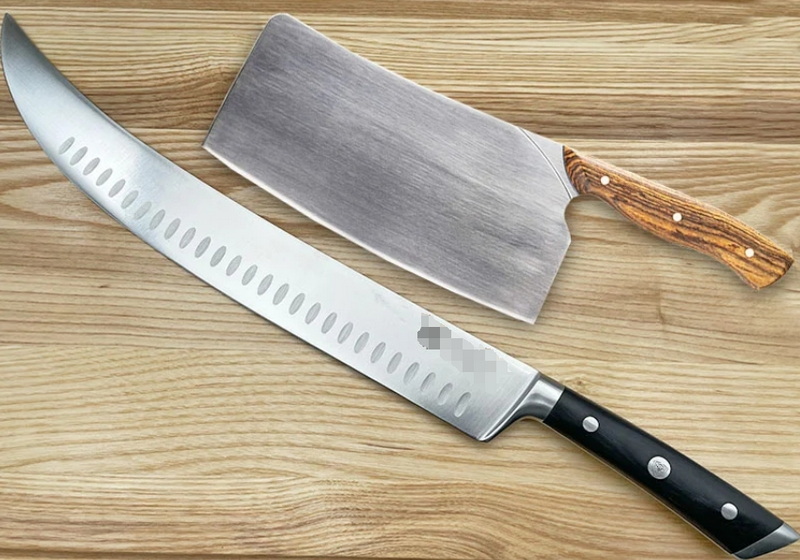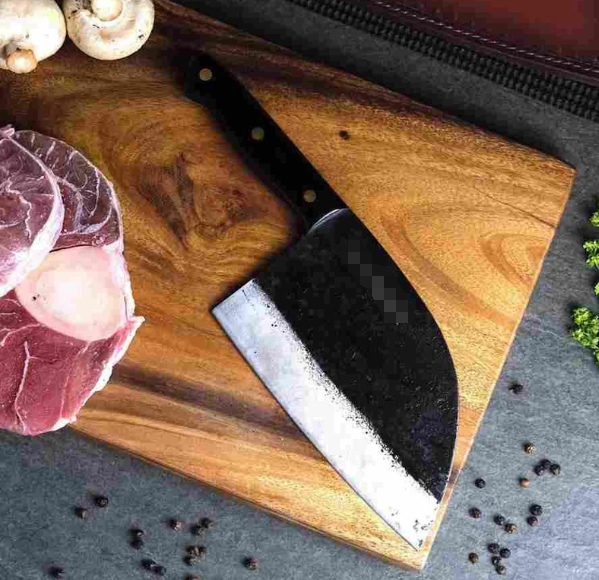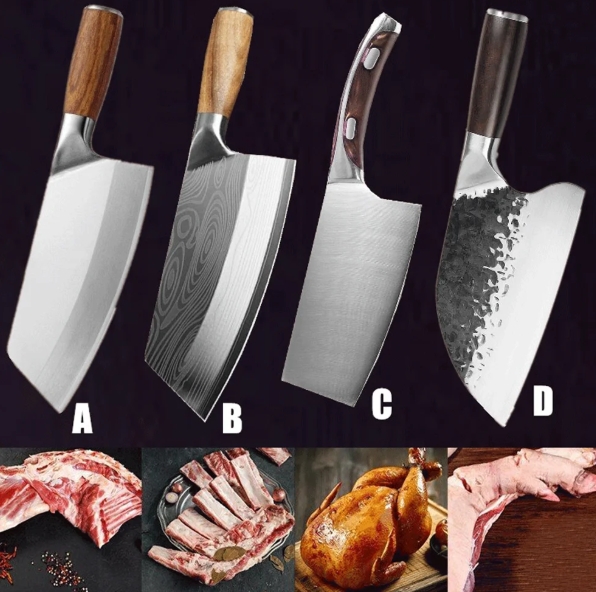

Views: 222 Author: Ella Publish Time: 2025-05-08 Origin: Site








Content Menu
● The Most Common Chef Knife Mistakes
>> Using the Wrong Knife for the Job
>> Cutting on the Wrong Surface
>> Holding the Knife Incorrectly
>> Using the Wrong Part of the Blade
>> Not Keeping the Knife Sharp
>> Not Cleaning the Knife Immediately
● How to Hold and Use a Chef Knife Correctly
>> Pinch Grip
● Choosing the Right Knife for the Task
● Maintaining and Storing Your Chef Knife
>> Cleaning
>> Storage
● Safe Knife Handling and Cutting Techniques
● Frequently Asked Questions (FAQ)
>> 1. What is the safest way to hold a chef knife?
>> 2. How often should I sharpen my chef knife?
>> 3. Can I put my chef knife in the dishwasher?
>> 4. What cutting surface is best for my chef knife?
>> 5. Why is a dull knife more dangerous than a sharp one?
A chef knife is the heart of any kitchen, a tool that transforms raw ingredients into culinary masterpieces. Yet, despite its importance, many home cooks-and even some professionals-make critical mistakes when handling, using, and caring for their chef knives. These missteps can lead to dull blades, wasted effort, and even serious injuries. Mastering the chef knife is not just about owning a high-quality blade; it's about understanding technique, maintenance, and safety. In this comprehensive guide, we'll explore the most common mistakes people make when using a chef knife, how to avoid them, and how to elevate your knife skills to professional standards.

Let's dive into the errors that can undermine your confidence and efficiency in the kitchen. By recognizing and correcting these mistakes, you'll unlock the full potential of your chef knife.
A chef knife is incredibly versatile, but it's not a universal tool. Many cooks make the mistake of using their chef knife for every task, from slicing bread to deboning meat. This can damage the blade and make tasks unnecessarily difficult. For example, a serrated knife is ideal for bread, while a paring knife is best for peeling or intricate work. Using a chef knife to cut through bones or frozen foods can chip or break the blade. Always select the right knife for each task to protect your tools and improve your results.
The surface you cut on has a major impact on your knife's longevity. Hard surfaces like glass, granite, or ceramic may look attractive, but they quickly dull your blade and can even cause chips. The best surfaces are wooden or high-quality plastic cutting boards. These materials provide enough give to protect your knife's edge while remaining sturdy and easy to clean. Always stabilize your cutting board with a damp towel underneath to prevent it from slipping during use.
A proper grip is essential for both safety and control. Many people grip the handle too far back or rest their index finger along the spine of the blade, which reduces control and increases the risk of slipping. The correct grip is the “pinch grip,” where you pinch the blade just above the handle with your thumb and index finger, then wrap your remaining fingers around the handle. This method maximizes control and allows for precise, efficient cuts.
A chef knife is designed with different parts for specific tasks. The tip is for delicate work, the heel is for tougher ingredients, and the center is for general slicing and chopping. Many cooks use only the center or the tip, neglecting the rest of the blade. Learning to utilize the full length of the blade increases efficiency and reduces wear on any one part of the knife.
A dull knife is not only inefficient but also dangerous. It requires more force to cut, increasing the likelihood of slipping and causing injury. Many home cooks neglect regular honing and sharpening, leading to frustration and accidents. Honing realigns the blade's edge and should be done before or after each use, while sharpening with a whetstone or professional service should occur every few months, depending on usage.
Storing chef knives loose in a drawer is a recipe for dull blades and accidental cuts. The best storage options are a knife block, magnetic strip, or protective sheath. These methods keep the blade protected and your fingers safe. If you must store knives in a drawer, use blade guards to prevent damage and injury.
Dishwashers are harsh environments for chef knives. High heat, strong detergents, and jostling can damage the blade and handle. Always hand-wash your knife with warm, soapy water, rinse it immediately, and dry it thoroughly before storing. Avoid soaking knives, as prolonged exposure to water can cause rust and damage wooden handles.
Improper cutting techniques are a leading cause of kitchen injuries. Cutting with your fingers exposed, using a sawing motion, or pressing straight down can lead to slips and cuts. The safest method is to use a “claw grip” with your non-knife hand, curling your fingers under and guiding the blade with your knuckles. Use a smooth rocking motion for most cuts, keeping the tip of the knife on the board and moving the blade up and down in a controlled arc.
Leaving food residue on your knife can cause stains, rust, and a dull edge. Acidic foods like tomatoes or citrus are especially damaging if left on the blade. Clean your knife immediately after use and dry it thoroughly to maintain its sharpness and appearance.
Forcing your knife through tough foods or bones can damage the blade and increase the risk of slipping. Let the sharpness of the knife do the work. If you encounter resistance, check if you're using the right knife for the job or if your blade needs sharpening.

Mastering the grip and motion of a chef knife is essential for both safety and efficiency.
- Pinch the blade just above the handle with your thumb and index finger.
- Wrap your remaining fingers around the handle.
- This grip maximizes control and reduces fatigue, allowing for precise, confident cuts.
- Curl your fingertips under, holding the food steady.
- Guide the blade with your knuckles, keeping your fingertips safely away from the edge.
- This technique not only protects your fingers but also helps maintain consistent, even cuts.
- Keep the tip of the knife on the cutting board.
- Rock the blade up and down, using the full length for slicing and chopping.
- This motion is efficient and keeps your knife in contact with the board, reducing the risk of slips.
Every kitchen task has an ideal knife. Using the right tool not only makes your work easier but also extends the life of your knives.
| Knife Type | Best For |
|---|---|
| Chef Knife | Chopping, slicing, dicing |
| Paring Knife | Peeling, trimming, small cuts |
| Serrated Knife | Bread, tomatoes, citrus |
| Cleaver | Bones, tough vegetables |
| Boning Knife | Removing bones from meat |
| Utility Knife | General-purpose slicing |
Understanding when to use each knife will improve your efficiency and protect your investment in quality cutlery.
Proper maintenance is the key to a long-lasting, razor-sharp chef knife.
- Hone your knife regularly to keep the edge aligned.
- Sharpen with a whetstone or professional service every few months, depending on how often you use your knife.
- A sharp knife not only performs better but is also safer to use.
- Always hand-wash your chef knife with warm, soapy water.
- Rinse and dry immediately to prevent rust and stains.
- Avoid abrasive sponges or cleaners that can scratch the blade.
- Store your knives in a knife block, on a magnetic strip, or in a protective sheath.
- If you must use a drawer, invest in blade guards to prevent damage and accidental cuts.
Safety should always be your top priority in the kitchen. Here are some essential tips:
- Always cut away from your body and keep your fingers clear of the blade.
- Keep your work area clean and dry to prevent slips.
- Never try to catch a falling knife-step back and let it fall.
- Store knives safely out of reach of children and pets.
- Maintain focus when using a knife; distractions can lead to accidents.
Mastering the chef knife is about more than just having the right tool-it's about how you use, maintain, and respect it. By avoiding the most common mistakes, you can cook more safely, efficiently, and enjoyably. Remember to match the knife to the task, use the correct grip and cutting technique, maintain a sharp edge, and store your knives properly. These habits will ensure your chef knife remains your most trusted kitchen companion for years to come.
Whether you're a beginner or an experienced cook, refining your knife skills will transform your cooking experience. Take the time to practice proper techniques, invest in quality tools, and treat your chef knife with the care it deserves. Your hands, your food, and your taste buds will thank you.

The safest grip is the “pinch grip,” where you pinch the blade just above the handle with your thumb and index finger, wrapping the rest of your fingers around the handle. This grip offers maximum control and reduces the risk of slipping.
Hone your knife before or after each use to keep the edge aligned. Sharpen your knife with a whetstone or professional service every few months, depending on how often you use it.
No. Dishwashers can damage the blade and handle due to high heat and harsh detergents. Always hand-wash your chef knife and dry it immediately.
Wooden cutting boards are the best choice, as they are gentle on your knife's edge and durable. High-quality plastic boards are also acceptable, but avoid glass, ceramic, or marble surfaces.
A dull knife requires more force to cut, increasing the risk of slipping and causing injury. A sharp knife glides through food with less effort, giving you more control and safety.